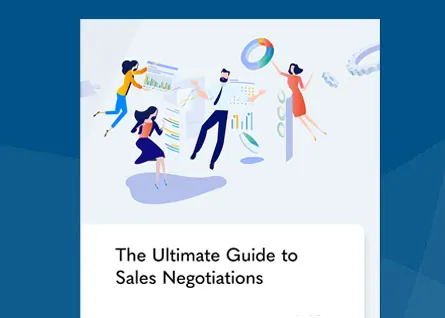How to Tactfully Disagree in a Sales Negotiation

In our white paper The Ultimate Guide to Sales Negotiations, we define a negotiation as a discussion or a series of discussions between two or more parties to resolve issues and agree to terms acceptable to all. The key words are “resolve issues.” If there are no issues and everyone readily agrees, there is no need for a negotiation. As we note, perhaps due to its close association with the word “negative,” many think negotiations must be contentious. While disagreement is unavoidable in a negotiation, both buyers and sellers benefit from understanding how to tactfully disagree to overcome impasses. Here are several ways sellers can disagree and still achieve win-win outcomes:
Know Your Facts
While there is some debate as to the merits of facts in winning an argument, few can argue against their appeal in a discussion. Perhaps the issue is how we define winning. If a win is changing the other person’s mind, making them agree with your position, that might be a tall order. However, if winning is enlightening them to understand your position, facts can help. For many sellers, case studies are an effective way to engage skeptical buyers because they contain black-and-white facts and figures, such as ROI, that cannot be dismissed. The more facts at your disposal, the more you can demonstrate the validity of your position and the potential for your solutions to allay fears and overcome objections.
Watch Your Tone
In grade school, teachers often make their hands into a T, like a timeout, to illustrate when a student’s tone is inappropriate or problematic. This is a useful image for all parties in a negotiation to remember. Often, it isn’t what we say. Instead, how we say it can cause disagreement or inflame tension. For example, when stressed or frustrated, it can be difficult to mask our incredulousness, impatience, or exasperation and easy for others to take offense. If the buyer expresses these things to you, take the higher ground, “Although we don’t see eye to eye on this, I do appreciate the need you express.” Change direction and try to find another.
Avoid Filler Words
Often, when we speak, our words can get ahead of our thoughts. When this happens, it can take a second to get back on track. For many people, this extra beat results in using filler words or sounds, such as “like,” “what I mean,” or the dreaded triumvirate “ah,” “um,” and “uh.” In a negotiation, this can make a seller seem unprepared or, even worse, disingenuous, like they’re trying to fake their way through a presentation. If you’re unsure of something, do not bluff. Instead, take a breath and admit you want to think about an issue. Speak clearly and enunciate. Like sellers, buyers always appreciate sincerity above dishonesty, even if that means a longer negotiation.
No Blame
Like filler words, our sentence structures can sometimes distort our meaning. We can thus unintentionally assign blame to another party. For example, there’s a huge difference between “Elliot was late getting back to me” and “Due to a miscommunication, there was a delay.” When negotiating, avoid expressions that can make others defensive. It’s much easier to overcome a disagreement when one party doesn’t feel like they dropped the ball. In a sales negotiation, snafus will happen. How we react often speaks volumes about a seller’s integrity and commitment to overcoming objections and reaching agreement.
It’s Business, Not Personal
As work is such an integral part of our lives, it can be easy to take things personally. There can be any number of reasons a buyer is skeptical about a solution, and the vast majority have nothing whatsoever to do with the seller. It could be the timing. It could be the price. It could be they are not fully committed. In any case, it is not necessarily an indication the seller has failed. Often, this can arise when a seller is so sure of their solution they lose sight of the client’s point of view. They can’t imagine why they don’t whip out their corporate card and get this deal done. Rather than disagree with the buyer, it’s best to reset and reapproach the issue.
Body Language
All sellers know, body language can be key to uncovering a client’s hidden needs or concerns. However, a seller’s own body language can reveal much about their own needs and motivations—sometimes more than they intend. For example, fidgeting can indicate a seller who is nervous or unsure. During a disagreement, a stiffened posture or folded arms can be seen as confrontational. At all times in a negotiation, sellers should be aware of their body language and recognize the signals they send. To keep the negotiation congenial, smile, nod, lean toward a client to establish a rapport. Keep eye contact to express genuine interest and a sincere desire to work thorough a disagreement.
Remember Must-Haves and Non-Negotiables
In the heat of a negotiation, sellers can be tempted to give in more than they want. This is especially true if a deal is in sight but held up by a recurring issue. Though it can be easy to shrug it off, it’s only later sellers realize their mistake. No matter how difficult a negotiation or how serious a disagreement, sellers must remember the needs they set as absolutes. Often, these are the very reason for the negotiation, and giving in would negate the deal’s profitability. Of course, while sellers can stress the point’s importance, there is no need to share its absolute status. This can shut down the negotiation. Instead, keep the buyer talking. There are other areas you can give to get more.
While disagreements are a part of the negotiation process, good sellers know to maintain their composure. Most disagreements are easily overcome so long as both parties remember their goals and keep their discussions tactful and congenial. Remember, the sales process starts because buyers have needs and sellers have solutions. Thereafter, both should work together, find common ground, and help each other achieve win-win outcomes. For more information, check out The Ultimate Guide to Sales Negotiations.

- Account Planning (11)
- Awards (50)
- Client Testimonial (37)
- Personal Branding (19)
- Podcast (11)
- Research (68)
- Sales Career Development (85)
- Sales Coaching (153)
- Sales Consulting (133)
- Sales Culture (164)
- Sales Enablement (340)
- Sales Leadership (108)
- Sales Management (242)
- Sales Negotiation (16)
- Sales Prospecting (124)
- Sales Role-Playing (18)
- Sales Training (229)
- Selling Strategies (255)
- Soft Skills (67)
- Talent Management (92)
- Trusted Advisor (27)
- Virtual Selling (41)
- Webinar (10)




























